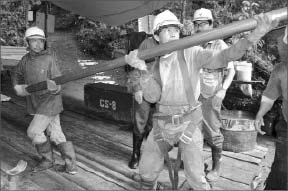Eleven of the 81 provinces in the Philippines have either imposed moratoriums on open-pit mining projects or on the mining of specific minerals, and a twelfth is set to soon join the list, according to Allan & Associates, a security risk management company that provides consulting services to mining companies in the Asia-Pacific region.
The mining moratoriums are technically illegal because they contravene existing national law under the 1995 Mining Act. But the initiatives by local governments can delay or even halt mining projects with little risk that the central government will use its full force to overturn them, Gavin Greenwood of Allan & Associates told The Northern Miner in an email interview.
“The country’s legal system would struggle to reach a definitive and enforceable ruling within a time frame likely to satisfy a foreign mining company or its investors,” he says.
Currently the provinces that have imposed restrictions include: Romblon, Palawan, Marinduque, Oriental Mindoro, Occidental Mindoro, Eastern Samar, Western Samar, Northern Samar, Bohol, Capiz and South Cotabato, Greenwood says. Another province, Zamboanga del Norte, may become the twelfth.
The ban on open-pit mining in South Cotabato potentially puts Xstrata‘s (XTA-L) Tampakan copper-gold project at risk. Production at Tampakan is forecast to start in 2016.
On March 31, Reuters reported that the governor of South Cotabato, Arthur Pingoy, “was still pushing for a review of the code banning open-pit mining that was put in place by his predecessor.”
Alison Flynn, a media spokeswoman for Xstrata in London, told The Northern Miner that the ban in South Cotabato was not an immediate concern because Tampakan was still in the exploration phase and not yet in construction.
“The Tampakan project is not immediately impacted by the South Cotabato environment code, which includes a ban on open-pit mining methods in the province, however we continue to monitor this issue closely,” she wrote in an emailed response to questions.
“Following the passage of the code last year, a wide range of stakeholders including the national government, host indigenous communities and local government units have called for a review of this legislation. We are hopeful that through continued dialogue and engagement with all parties involved, there will be a timely resolution regarding this matter.”
Tampakan is situated on the boundaries of three provinces – South Cotabato, Sultan Kudarat and Davao del Sur – on the southern island of Mindanao, about 65 km north of General Santos City.
It is one of the biggest undeveloped copper-gold deposits in Southeast Asia with a resource of 2.4 billion tonnes at 0.6% copper and 0.2 gram gold per tonne, for 13.5 million tonnes copper and 15.8 million oz. gold.
Greenwood of Allan & Associates notes that the parochial nature of Philippine politics reflects the country’s fragmented geography and a colonial era that witnessed some groups favoured over others.
“These factors, and the experience of authoritarian rule ended by ‘People Power’ revolts in the 1980s, have weakened the central government’s leverage over the provinces,” he explains. “The present government’s position is also complicated by its need to balance local aspirations with meeting a budget under a weak president with no deep political hinterland.”
And making headway with local communities who resist mining is extremely difficult, he says. “Opposition ranges from the senior ranks of the Catholic Church to the communist guerrillas of the New People’s Army… This leaves foreign mining companies having to engage in the most minute and detailed calculations at a micro-level within the communities they are seeking to operate, rather than relying on legal or central government intervention to support their operations.”
Mining companies that are not affected by the bans and have producing gold mines in the country include Medusa Mining (MLL-T, MML-L, MML-A) and CGA Mining (CGA-T,CGX-A), both of which say they have very good relationships with the communities in which they are active.
“It’s a great place to operate,” says Mark Savage, CGA Mining’s chairman. “It’s not that different from anywhere else. Everybody has got the same environmental standards and you’ve got to adhere to them and local politics everywhere need to be catered to and dealt with and you need to work with the local communities. It’s
the same whether you’re in Nevada or in the Philippines.
“The Philippines is having a tremendous mining renaissance and more and more mining companies are going over there,” he continues. “There are some great mines there and you can build mines there as Medusa and CGA have proved.”
For his part, Geoffrey Davis, Medusa’s managing director, says his company is not affected in the two provinces in which it operates, but offers this advice:
“As a rule of thumb, if you are developing in a province with a history of mining, there are generally minimal problems as many people are there because of mining. If in a province with no history of mining, there can be some more difficult hurdles.”


Be the first to comment on "Charting the shoals in the Philippines"